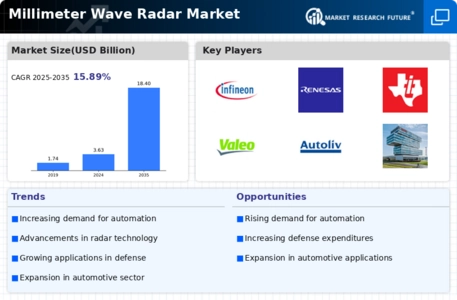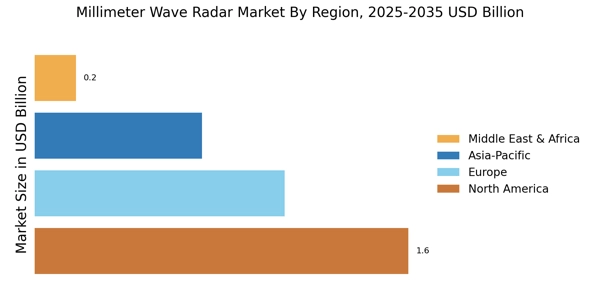The Millimeter Wave Radar Market is currently characterized by a dynamic competitive landscape, driven by advancements in technology and increasing demand across various sectors, including automotive, aerospace, and defense. Key players such as Northrop Grumman (US), Raytheon Technologies (US), and Thales Group (FR) are strategically positioned to leverage their technological expertise and extensive portfolios. Northrop Grumman (US) focuses on innovation in radar systems, particularly in defense applications, while Raytheon Technologies (US) emphasizes partnerships and collaborations to enhance its product offerings. Thales Group (FR) is actively pursuing regional expansion, particularly in Europe and Asia, to capitalize on emerging market opportunities. Collectively, these strategies contribute to a competitive environment that is increasingly shaped by technological advancements and strategic partnerships.
In terms of business tactics, companies are localizing manufacturing and optimizing supply chains to enhance operational efficiency and reduce costs. The market structure appears moderately fragmented, with several key players holding substantial market shares. This fragmentation allows for a diverse range of products and services, fostering competition among established firms and new entrants alike. The collective influence of these key players is significant, as they drive innovation and set industry standards, thereby shaping the overall market dynamics.
In August 2025, Northrop Grumman (US) announced a partnership with a leading automotive manufacturer to develop advanced millimeter wave radar systems for autonomous vehicles. This collaboration is strategically important as it positions Northrop Grumman at the forefront of the rapidly evolving automotive sector, where the demand for sophisticated radar technology is surging. By aligning with a major player in the automotive industry, Northrop Grumman aims to enhance its market presence and drive innovation in vehicle safety and automation.
In September 2025, Raytheon Technologies (US) unveiled a new line of millimeter wave radar systems designed for both military and civilian applications. This launch reflects Raytheon's commitment to innovation and its strategy to diversify its product offerings. The introduction of these systems is likely to strengthen Raytheon's competitive position, as it addresses the growing need for versatile radar solutions that can be utilized across various sectors, including defense and transportation.
In July 2025, Thales Group (FR) expanded its operations in Asia by establishing a new manufacturing facility dedicated to millimeter wave radar technology. This strategic move is indicative of Thales's focus on regional expansion and its intent to tap into the burgeoning demand for radar systems in the Asia-Pacific region. By localizing production, Thales aims to enhance its responsiveness to market needs and reduce lead times, thereby gaining a competitive edge in this rapidly growing market.
As of October 2025, current competitive trends in the Millimeter Wave Radar Market are increasingly defined by digitalization, sustainability, and the integration of artificial intelligence. Strategic alliances among key players are shaping the landscape, fostering innovation and enhancing product capabilities. Looking ahead, competitive differentiation is likely to evolve from traditional price-based competition to a focus on technological innovation, reliability in supply chains, and the ability to meet sustainability goals. This shift underscores the importance of adaptability and forward-thinking strategies in maintaining a competitive advantage in the millimeter wave radar sector.


















Leave a Comment